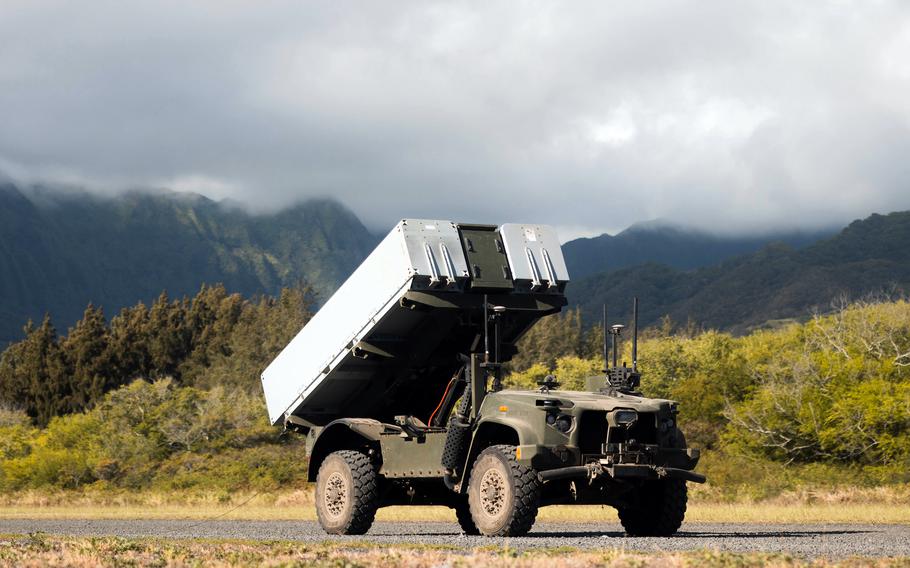
The Navy-Marine Expeditionary Ship Interdiction System, or NMESIS, will be used during two upcoming exercises in the Philippines. (Eric Huynh/U.S. Marine Corps)
The Marine Corps is leaving anti-ship missile batteries in the Philippines after the upcoming Balikatan drills in preparation for another exercise in June, according to a Marine spokeswoman.
The Navy-Marine Expeditionary Ship Interdiction System, or NMESIS, is coming with the 3rd Marine Littoral Regiment for the April 21-May 4 Balikatan exercise, 1st Lt. Annie Pentaleri, spokeswoman for the regiment, said by email Tuesday.
NMESIS systems and 75 Marines will remain behind after Balikatan until the Kamandag exercise the following month, she said.
All told, 1,000 Marines with the littoral regiment will take part in Balikatan — Tagalog for “shoulder to shoulder” — and Kamandag, Pentaleri said.
The 3rd Littoral Combat Team’s Medium-Range Missile Battery operates NMESIS, she said.
The combat team, stationed at Marine Corps Base Hawaii, acquired the weapon in November. It plays a role in the Corps’ Force Design strategy, which calls for small units of Marines positioned on island choke points to deny adversaries passage through contested seas.
The mobile system includes missile launchers, a 7-ton vehicle and two Joint Light Tactical Vehicles, Pentaleri said.
Deploying weapons to the Philippines for exercises and leaving them there for extended periods strengthens deterrence, according to Ralph Cossa, former president of the Pacific Forum think tank in Hawaii.
By exercising with its allies, improving their military forces and prepositioning equipment, the U.S. sends a message that it can defend itself and its allies against Chinese attack, he said by email Tuesday.
The U.S. also proposes to sell the Philippines 20 advanced F-16 Fighting Falcons and a suite of equipment and munitions worth $5.6 billion, the Defense Security Cooperation Agency announced April 1.
Defense Secretary Pete Hegseth said during a visit to Manila last month that NMESIS would accompany the Marines to Balikatan.
This year’s exercise will be a “full battle test” by 10,000 U.S. troops and 6,000 service members from the Philippines, Australia and Japan, according to U.S. and Filipino military officials.
“The Full Battle Test will demonstrate how the tactical actions of service members have operational effects for the multilateral force,” Lt. Gen. Michael Cederholm, commander of I Marine Expeditionary Force, said Monday in a news release from the Balikatan Combined Joint Information Bureau. “Doing so allows us to validate, refine and improve our combined capability to defend the Philippines.”
Kamandag was last held in October with more than 1,000 Marines, 1,100 Filipino troops and smaller contingents from Japan, South Korea, Australia and Great Britain practicing coastal defense and a range of other skills across the Philippines.
During both upcoming exercises the 3rd Marine Littoral Regiment “will be dispersed across various locations around Northern Luzon and the Batanes Islands,” Pentaleri said. Luzon is the largest island in the Philippine archipelago; the Batanes Islands, 233 miles southeast of Taiwan, is its northernmost territory.
During Balikatan, the littoral regiment will take part in integrated air- and missile-defense training, maritime key-terrain security operations, counter-landing live fire and maritime strike training, she said.
The Marines will train alongside Philippine marines of the 4th Marine Brigade and the Coastal Defense Regiment, Pentaleri said.
The NMESIS system fires anti-ship Naval Strike Missiles with a range of around 115 miles. The missile alone costs nearly $2.2 million, according to a Naval News report in November 2022.
The Army’s Typhon missile system, positioned in the Philippines since spring 2024, has a range of more than 1,000 miles.
The missile deployments come as Washington and its allies in the region prepare for potential conflict with Beijing over Taiwan and the South China Sea. Philippine and Chinese coast guard vessels have clashed multiple times over the past year in disputed waters.